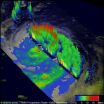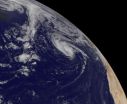(Press-News.org) MADISON -- Among his many qualities, the pioneering wildlife ecologist Aldo Leopold was a meticulous taker of field notes.
Rising before daylight and perched on a bench at his Sauk County shack in Depression-era Wisconsin, Leopold routinely took notes on the dawn chorus of birds. Beginning with the first pre-dawn calls of the indigo bunting or robin, Leopold would jot down in tidy script the bird songs he heard, when he heard them, and details such as the light level when they first sang. He also mapped the territories of the birds near his shack, so he knew where the songs originated.
Lacking a tape recorder, the detailed written record was the best the iconic naturalist could do.
"Leopold took amazing field notes," says Stan Temple, a University of Wisconsin-Madison emeritus professor of wildlife ecology and now a senior fellow of the Aldo Leopold Foundation. "He recorded his observations of nature in great detail."
Using those notes, Temple and Christopher Bocast, a UW-Madison Nelson Institute graduate student and acoustic ecologist, have recreated a "soundscape" from Leopold's 70 year-old notes. But the dawn chorus that Leopold heard in 1940 no longer exists at the shack, Temple explains. The mix of species today is different due to changes in the landscape and changes in the bird community around the shack.
More noticeable is the thrum of the nearby interstate highway, audible at every hour from Leopold's storied sanctuary, and the other constant and varied noises of the human animal. Since Leopold's time, for example, the internal combustion engine has roared to soundscape dominance, whether as an airplane overhead, a rumbling motorcycle, a whining chain saw or an outboard churning on the nearby Wisconsin River.
"The difference between 1940 and 2012 is overwhelmingly the anthrophony – human-generated noise," explains Temple. "That's the big change. In Leopold's day there was much less of that."
The resurrected soundscape of 1940s Sauk County is the first to be recreated from actual data rather than someone's imagination of what the past sounded like, says Temple. The work fits into an emerging field of science known as soundscape ecology, which seeks to explain the role of sound within a landscape and how it influences the animals -- birds, insects, amphibians, even fish -- that live there.
Recently, a rarefied group of scholars who work in the new field met at the Leopold Center, just a few hundred yards from Leopold's humble shack. The National Science Foundation-sponsored workshop drew not only scientists but philosophers, musicians and others with an interest in natural sounds. Temple gave the opening keynote, which featured the reconstructed dawn chorus.
"Aldo Leopold recognized that you can get a pretty good sense of land health by listening to the soundscape," Temple says. "If sounds are missing and things are there that shouldn't be, it often indicates underlying ecological problems."
The soundscape produced by Temple and Bocast is a compressed version of the chorus described by Leopold, taking 30 minutes of notes and compressing them into five minutes of recording. Bird songs and calls were obtained from the extensive collection housed at the Cornell Lab of Ornithology's Macaulay Library.
The background sound on which they superimposed the bird songs is all Wisconsin, but Temple and Bocast struggled to find a place where human noise was as it would have been in Leopold's time: "There are combustion engines on the edge of hearing all the time," says Bocast, whose dissertation work includes a bioacoustic study low frequency sounds made by spawning sturgeon.
Citing a recent study, Temple points out that in the lower 48 states, there is no place more than 35 kilometers from the nearest road, making it nearly impossible to tune out the hum of human activity, even in places designated as wilderness.
"It is increasingly difficult to study natural soundscapes that represent normality," says Temple, noting that its not just mechanical human noise that's encroaching. The rain forests of Hawaii, for example, no longer sound like the rain forests of Hawaii. "They sound more like the rain forests of Puerto Rico because the calls of an introduced, invasive tree frog are becoming pervasive."
Preserving the natural sounds of a place, avers Temple, may be just as challenging as conserving the mosaic of plants and animals that help keep an ecosystem intact. Like smell and sight, "sound can be what you associate with a particular landscape," something Leopold appreciated and wrote about in several of his well known essays.
By noting and studying the role of sound in the natural world, Leopold proved again to be ahead of his time. Science is only now coming to grips with the totality of the sounds of nature (much like the sound of an entire orchestra) rather than the individual components of the soundscape, according to Temple.
Understanding how nature's "music" is changing and how much attention we need to pay to the sounds introduced by people, he says, are challenges for soundscape ecologists. And we have much to learn about what the noise people make does to the environment.
INFORMATION:
-- Terry Devitt (608) 262-8282, trdevitt@wisc.edu
END
HOUSTON – (Sept. 18, 2012) – Contrary to the prevailing theories that music and language are cognitively separate or that music is a byproduct of language, theorists at Rice University's Shepherd School of Music and the University of Maryland, College Park (UMCP) advocate that music underlies the ability to acquire language.
"Spoken language is a special type of music," said Anthony Brandt, co-author of a theory paper published online this month in the journal Frontiers in Cognitive Auditory Neuroscience. "Language is typically viewed as fundamental to human intelligence, ...
Although depression and prejudice traditionally fall into different areas of study and treatment, a new article suggests that many cases of depression may be caused by prejudice from the self or from another person. In an article published in the September 2012 issue of Perspectives on Psychological Science, a journal of the Association for Psychological Science, William Cox of the University of Wisconsin-Madison and colleagues argue that prejudice and depression are fundamentally connected.
Consider the following sentence: "I really hate _____. I hate the way _____ look. ...
While wave watching is a favorite pastime of beachgoers, few notice what is happening in the shallowest water. A closer look by two University of Colorado Boulder applied mathematicians has led to the discovery of interacting X- and Y-shaped ocean waves that may help explain why some tsunamis are able to wreak so much havoc.
Professor Mark Ablowitz and doctoral student Douglas Baldwin repeatedly observed such wave interactions in ankle-deep water at both Nuevo Vallarta, Mexico, and Venice Beach, Calif., in the Pacific Ocean -- interactions that were thought to be very ...
ANN ARBOR, Mich. — A small subset of patients with open-angle glaucoma (OAG) account for a large proportion of all glaucoma-related charges in the United States, according to new data published by researchers at the University of Michigan Kellogg Eye Center and Washington University, St. Louis.
These findings have importance for future evaluations of the cost-effectiveness of screening and treatment for glaucoma.
"We've identified risk factors associated with patients who are the costliest recipients of glaucoma-related eye care," says Joshua D. Stein, M.D., M.S., ...
Powerful thunderstorms wrapped tightly around Hurricane Lane's center as it continued moving through the eastern Pacific Ocean. When NASA's Terra satellite passed over Lane it captured a close-up view of the storm and noticed that Lane's eye had become cloud-filled as if being punched in the eye. Nature is expected to fight Lane more and win over the next couple of days.
The Moderate Resolution Imaging Spectroradiometer (MODIS) instrument captured a close-up of Lane on Sept. 17 at 3:25 p.m. EDT when it was still a hurricane. In the image, Lane's eye appeared obscured ...
Heavy rainfall from Typhoon Sanba caused flooding, landslides and at least one death when it hit South Korea on Monday September 17, 2012. NASA's TRMM satellite captured rainfall and thunderstorm cloud height data as Sanba drenched southwestern Japan earlier, and its eye passed to the west of the Japanese island of Kyushu.
The Tropical Rainfall Measuring Mission (TRMM) satellite provided good coverage of Sanba as it passed over Typhoon Sanba on Sept. 16, 2012 at 0349 UTC, after Sanba had passed over Okinawa, Japan. Sanba was moving northward over the East China Sea toward ...
BETHESDA, Md. (Sept. 18, 2012)—Diabetic nephropathy is one of the most serious complications related to diabetes, often leading to end-stage kidney disease. Purple corn grown in Peru and Chile is a relative of blue corn, which is readily available in the U.S. The maize is rich in anthocyanins (also known as flavonoids), which are reported to have anti-diabetic properties. Scientists from the Department of Food and Nutrition and Department of Biochemistry at Hallym University in Korea investigated the cellular and molecular activity of purple corn anthocyanins (PCA) to determine ...
VIDEO:
This animation of satellite observations from Sept. 14-18, 2012, shows Tropical Storm Nadine in the central Atlantic. NASA's HS3 Mission Global Hawk investigated Nadine on Tropical Storm Nadine on Sept....
Click here for more information.
Tropical Storm Nadine is nearing the Azores and watches have gone up for the northwestern group of the islands. NOAA's GOES-13 satellite captured a visible image of Nadine as it continues moving northeast through the Atlantic.
On ...
DURHAM, N.C. – Better adherence to the DASH (Dietary Approaches to Stop Hypertension) diet is associated with significant reductions in blood pressure. However, African-Americans may be less likely than whites to adopt the diet, according to researchers at Duke University Medical Center.
The findings, which appear online September 19 in the Journal of the Academy of Nutrition and Dietetics, suggest that altering traditional recipes to meet nutritional guidelines rather than eliminating certain foods altogether may result in better adherence among African-Americans.
The ...
Philadelphia, PA, September 19, 2012 – The Dietary Approaches to Stop Hypertension (DASH) diet, which promotes consumption of more fruits, vegetables, low-fat dairy products, and whole grain, and less meats and sweets, is a proven effective treatment for hypertension. For some individuals, adherence to the diet can be just as effective in lowering blood pressure as taking antihypertensive medication. A new study has found that greater adherence to the diet can lead to significant reductions in blood pressure, but that African Americans are less likely to adopt the diet ...



